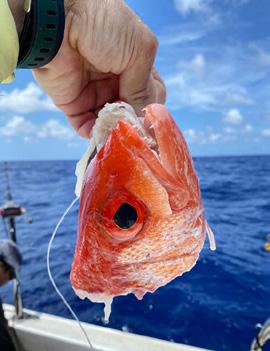
2 minute read
Socioeconomic Context for Fisher-Shark Interactions in the Mariana Archipelago
Fishers in Guam and the Commonwealth of the Northern Mariana Islands (CNMI) have long expressed frustration and concern about their interactions with sharks while fishing. Government officials’ and fishing communities’ pleas for assistance from the Western Pacific Regional Fisheries Management Council date back to 1979. The Council has repeatedly recommended that shark abundance and depredation studies be done in the Mariana Archipelago, referencing its fisheries’ high shark interaction and depredation rates which could negatively impact fisher catch per unit effort (CPUE) and income. Social media has played a key role in documenting these interactions, allowing the fishing community to share photos of sharkbitten fish. But shark research in the region has remained limited. To better understand the impact of fisher-shark interactions on fishing communities and reflect on potential solutions, scientists at the Joint Institute of Marine and Atmospheric Research (JIMAR) and the PacificIslands Fisheries Science Center (PIFSC) conducted a joint study in 2019–2020.

Guam fishermen expressed their frustration with shark interactions to JIMAR and PIFSC researchers, with their observations suggesting that sharks may be increasingly conditioned to fishing activity.
Photo: Capt. James Borja.
Advertisement
Scientists collected data by engaging with more than 100 people in Guam and the CNMI islands of Saipan, Rota and Tinian through interviews, stakeholder meetings, fisher-organized gatherings and conversations with boat fishers returning from or departing for fishing trips. The majority of the research participants were fishers, but the group also included scientists and managers. Council staff and regional advisory panels took part in the stakeholder meetings.
The resulting report compared participants’ perceptions of sharks and mitigation strategies, which were then put into a broader socioeconomic context. Research participants described various impacts of fisher-shark interactions including loss of gear, damaged equipment, and increased safety risks and fishing trip costs. The costs include frequent shifting of fishing locations, time and fuel, resulting in impacts to CPUE. Many participants also expressed confusion regarding shark regulations, and concerns about the lack of shark research in the Mariana Archipelago and sharks being underutilized/ wasted as a food resource.
Scientists noted a disconnect between fishers’ observations of increasing shark interaction frequencies and existing shark research, which has indicated depleted reef shark populations. For example, the Guam Division of Aquatic and Wildlife Resources’ coastal aerial surveys over a 40-year period show an 84% decrease in reef shark density. However, fishers described pelagic sharks more often using negative, problematic descriptors than reef sharks. Given limited scientific information, understanding the Mariana Archipelago’s shark populations and changes in shark abundance, particularly for pelagic species, represents a research priority from both the scientific and fishery perspectives.
Shark behavior represents a possible bridge between stakeholders’ conflicting perceptions of sharks. Fishers’ observations suggest that sharks may be increasingly conditioned to fishing activity. Research participants noted increasing shark interaction frequency, numbers, aggression, prey diversity, broadening shark distribution and responsiveness to fishing cues. The latter included descriptions of sharks arriving more quickly to fishing activity and biting unbaited artificial lures. Participants discussed decreasing fish abundance and size, shark finning bans, increases in fishing participation (and thus fishing effort) and changes to fish aggregating devices as being potentially related to these changes. Whatever the cause, structuring discussions around changing shark behavior may offer a more productive common ground for fishers, scientists and managers.

Fisherman Adam San Gil recovered the carcass of a sunfish (moa) from the east side of Guam that had been eaten by sharks.
Photo: Adam San Gil.










